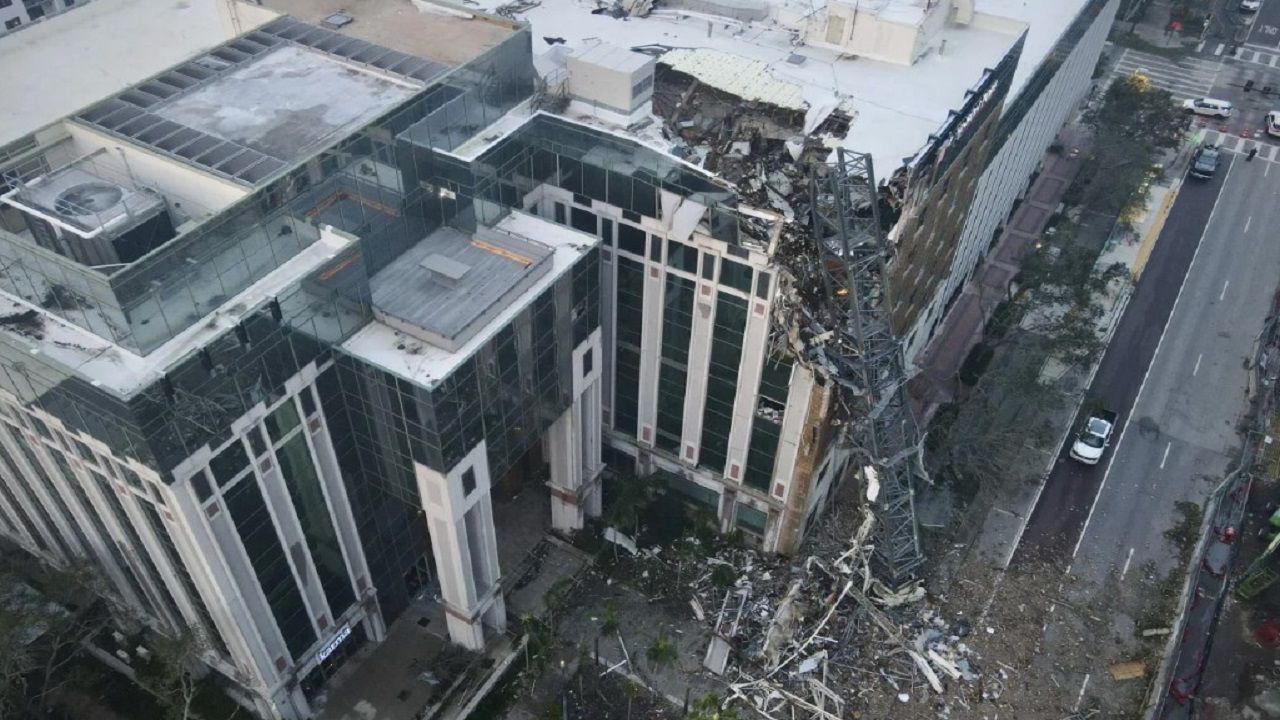ST. PETERSBURG, Fla. — One of the stunning images after Hurricane Milton was the damage to a downtown St. Pete building after a collapsed crane crashed into it before slamming to the ground.
No one was injured when the crane working on The Residences at 400 Central Avenue, a 46-story condominium and office building which will be the tallest residential tower on Florida’s Gulf Coast, crashed into a nearby building where the Tampa Bay Times is located.
What You Need To Know
- St. Pete city council to discuss aftermath of crane collapse during Milton at this week's city council meeting
- No one was injured when the crane working on The Residences at 400 Central Avenue, a 46-story tower, crashed into a nearby building
- PREVIOUS STORY: Developer releases statement about St. Pete crane collapse
But the twisted metal gouged a hole where part of it came to rest in the brick and concrete on one corner of the building. Wires dangled down and bits of office items were strewn about.
Now, some downtown residents and business owners, as well as city officials, plan to ask what more can be done with other cranes on area construction sites. The topic is expected to be an issue of discussion at a city council meeting on Thursday.
The project developer released a statement days after the incident.
"We are grateful that no one was injured. The general contractor and crane subcontractor have engaged engineering specialists to supervise removing debris, and we expect they will begin removal soon," developer Cats Red Apple Group said in a statement."It does not appear that the 400 Central structure was damaged and thorough inspections are being performed."
The crane was one of four that St. Petersburg officials warned were vulnerable to Milton's wind.
Development is booming across downtown St. Pete and Mickey’s Café owner Mickey Paleologos has seen plenty of it in his 20 years in business downtown, 11 at his current Central Avenue location.
“The growth is always great for the city, however it’s got its problems too,” said Paleologos. “(But) the biggest problem that not only me but the businesses around here have is, the construction.”

A construction crane fell over into an office building in downtown St. Petersburg during Hurricane Milton. (Tampa Bay Times via AP)
The 400 Central skyscraper was designed to top out at 515 feet. It will have 301 condos at a minimum price of $1 million, along with retail and office space, the Tampa Bay Times reported.
It will probably require at least one more crane to dismantle the twisted mess, just like construction crews usually need another crane to start building a crane.
Most structures that build skyscrapers are called tower cranes, and they are able to build their own tower higher as the building goes up.
The key part of crane safety is carefully balancing all the competing weights and forces.
Palelogos said the sidewalks being blocked and a lack of parking were his biggest problems up until he learned about the threats of a crane falling during hurricane Milton.
Then seeing one of those cranes come crashing down.
“I’m like ooh! It was literally a hundred meters from here,” he said of the crane crash. “(About) 150 meters from here. Not only the crane but also the building on the corner. The side of those walls blew out as well.”
He watched the drama unfold from a distance, wondering if his business would be impacted.
“We couldn’t even get into our business until four days later because they blocked all of the streets from First Avenue North to Second Avenue South, he said. “Second to Fourth. So, nobody could come close. Even to check on your business."
It’s something that’s not lost on city Councilwoman Gina Driscoll.
“The cranes are a real issue in our city and this came as kind of a surprise to me that not all of the companies were able to secure their cranes before the storm,” Driscoll said.
She said state law prohibits city leaders from passing regulations on cranes but she’s looking for other options to protect residents and local businesses in the future.
“The idea here is to encourage our construction companies working in St. Petersburg to use the best kind of crane possible that can withstand those higher winds,” Driscoll said. “They do exist and we want them to use the safest product possible.”
If a crane stayed in one spot, the wind would provide more resistance, like a hand stuck in a river. But if the boom can turn, the wind can blow alongside it and reduce that resistance, according to Barth Crane Inspections in Goose Creek, South Carolina.
Barth officials said most cranes are designed for winds of at least 100 mph and those in places like Florida, where hurricanes are a greater hazard, often have a greater wind resistance.
But there is only so much force a crane can handle.
That’s why Mayor Kenneth Welch warned anyone living near construction projects that use a crane to leave, and police made sure areas threatened were cleared.
Driscoll said she plans to present her concerns to city leaders and ask for it to be sent to a committee. She also said she’d like the city to look into what options are available for crane safety.
She said she doesn’t want the city leaving residents or business owners hanging if another storm rolls in.
“I think once it’s all said and done, it should be and it always has been a vibrant city,” Paleologos said. “I enjoy living in St. Petersburg. We just got to get through this hard time with this construction.
“We’ll see.”
Information from the Associated Press was used in this report.



